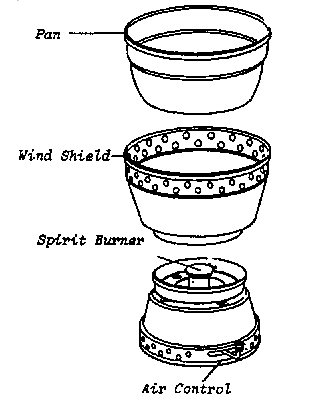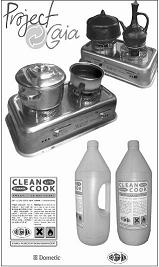Knowledge fuels change - Support energypedia!
For over 10 years, energypedia has been connecting energy experts around the world — helping them share knowledge, learn from each other, and accelerate the global energy transition.
Today, we ask for your support to keep this platform free and accessible to all.
Even a small contribution makes a big difference! If just 10–20% of our 60,000+ monthly visitors donated the equivalent of a cup of coffee — €5 — Energypedia would be fully funded for a whole year.
Is the knowledge you’ve gained through Energypedia this year worth €5 or more?
Your donation keeps the platform running, helps us create new knowledge products, and contributes directly to achieving SDG 7.
Thank you for your support, your donation, big or small, truly matters!
Alcohol Stoves
Basics | Policy Advice | Planning | Designing and Implementing (ICS Supply)| Technologies and Practices | Designing and Implementing (Woodfuel Supply)| Climate Change
Introduction
Stoves fueled with alcohol (ethanol and methanol) are not widely used in households. They are mainly used in areas where such stoves and fuels have been fostered and promoted by studies and projects.
Cooking with Alcohol Stoves
A stove to burn alcohol fuels can be very simple. It can be made relatively cheaply in countries with industries producing articles such as aluminium pots, etc.
The main components of the burner are shown here[1]:
Alcohol stoves have a very clean combustion, emit no soot and negligible emissions. Cooking is very fast as heat is available instantly after ignition of the fuel.
For further advantages and disadvantes of alcohol as a fuel see also the article onCooking with Ethanol and Methanol.
Experiences of Cooking with Ethanol Stoves
The most documented ethanol stove model is the CleanCook Stove by CleanCook Sweden AB, which is produced in South Africa and promoted mainly by Project Gaia.
The "CleanCook" Stove is available as a single or double-burner model for households and institutions. It is made from aluminium or stainless steel. The CleanCook is a non-pressurized alcohol stove with a refillable fuel canister of a capacity of 1,2 liters.[2] The canister contains a porous fiber that adsorbs alcohol and retains it in a manner that prevents spills, leaks, fires and explosions.[3] The power output per burner is rated at 1.8 kW at maximum heat, allowing for a cooking time of 4-5 hours. It can burn ethanol and methanol.[2]
Up to now, 55,000 cleancook stoves have been provided, mainly in Africa.[4]
Project Gaia and its Ethiopian sister organization, Gaia Association, have lab and field tested alcohol stoves since 2005. To date, alcohol stoves have been used by households in Ethiopia, Nigeria, South Africa, Malawi, Madagascar, Mozambique, Vietnam, Brazil and Haiti. Click here to access country study/project reports. The largest number of households using alcohol stoves is in the UNHCR refugee camps near Jijiga, Eastern Ethiopia where more than 4,000 households rely on the CleanCook stove and ethanol fuel as their main source of energy. The UNHCR now aims to scale up to provide ethanol cookstoves and fuel to up to 27,678 households by 2017.[5]
Project Gaia currently leads four community-based, small-scale ethanol distillation projects in Ethiopia. Also in Brazil and Haiti microdistillery projects are being implemented. These projects aim to allow communities to produce clean cooking fuel using local feedstocks, simultaneously adding value to agricultural markets by taking advantage of co-products of the distillation process[6].
Further Information
- Cooking with Ethanol and Methanol, article on energypedia
- HEDON Household Energy Network: This network provides information on all aspect of ethanol as a household fuel
- The ‘Cookstove Fuels’ section of the Global Alliance for Clean Cookstoves
- Project Gaia homepage
- Ten Years in Ethiopia: A look back at the last decade. Project Gaia (January 2015).
- link to ethanol fuel article
References
This article was originally published by GIZ HERA. It is basically based on experiences, lessons learned and information gathered by GIZ cook stove projects. You can find more information about the authors and experts of the original “Cooking Energy Compendium” in the Imprint.
- ↑ http://www.hedon.info/BP33_EthanolStovesForMauritius?bl=y
- ↑ 2.0 2.1 http://cleancook.com/productsstove-sales/
- ↑ https://en.wikipedia.org/wiki/Project_Gaia#The_CleanCook_Stove
- ↑ http://cleancook.com/about-us/
- ↑ http://us4.campaign-archive2.com/?u=541b5acf6da7c1b89cf4193b7&id=849ff674b0&e=da11811f02
- ↑ http://www.projectgaia.com/index.php
--> Back to Overview GIZ HERA Cooking Energy Compendium
Plant Oil Cookers
Introduction
Plant oil stoves can be used with different vegetable oils, such as palm oil, jatropha oil, etc.
Due to their high viscosity, plant oils need to be burnt in pressure stoves. Pressure is induced in a tank through application of a pump. The liquid evaporates in a vaporizer and emits through a nozzle into a combustion area. The jet rebounds at a rebounding plate, mixes with ambient air and burns in a blue flame. The combustion area is surrounded by a flame holder. The power output can be adjusted with a valve regulating the fuel flow. For ignition, a small amount of ethanol is incinerated in a preheating dish beneath the vaporizer.[1]
Challenges in Cooking with Plant Oil Stoves
During the last decades, several projects have sought to design household appliances for cooking and heating that use plant oil. They mostly failed because of the following reasons:
- Plant oil cookers have a rather complicated design, which is not easy to construct.
- Simmering: in a pressurized system regulating the plant-oil supply down for small heat poses a challenge.
- They require ongoing maintenance and cleaning: Plant oils contain fiber that remains behind as the oil is burned to gas. The fiber tends to clog the burner (depending on the type of stove), requiring regular cleaning of stove and nozzles. The amount of fiber depends on the kind of oil and the quality of the filter method applied.
- Noise: if burned in a pressurized system, cooking with plant oil can be quite noisy. It requires muffling of the sound.
- Production of plant oil is labour-intensive and expensive.
- In most cases, production of fuelwood is much easier and much cheaper than production of plant oil.
For further advantages and disadvantages of plant oil as a fuel see also this article on energypedia.
Protos the Plant Oil Stove
Starting in 2004, the University Hohenheim (Germany), in cooperation with Bosch and Siemens Home Appliances Group (BSH), developed protos the plant oil cooker. The basic idea was to develop a cookstove that can use a variety of plant oils; even recycled and filtered oil previously used for frying.
Field tests in the Philippines and in Tanzania showed that households and small enterprises such as restaurants that were previously cooking on 3-stone fires, can handle the Protos stove. People stated that they enjoyed the comfort of cooking and said it was like cooking on gas, even if LPG was not available. Based on observations from the field tests, BSH developed a 'second generation' of the Protos technology to increase efficiency, reducing noise, cleaning time and the cost of production.[2] The serial production was launched in May 2010 in Indonesia. Initial costs were considered to be around US$40 - 42, at a production rate of around 25,000-50,000 units in 2010.[3]
However, in 2012, BSH decided to conclude the Protos plant oil cooker project and to discontinue series production of the stove in Indonesia. The main reasons were as follows:[4]
- The stove was required to be of a high quality, safe and as easy as possible to use. Equally, however, it had to be cheap enough for people in developing countries to be able to afford it. The low purchasing power of the potential users had limited the use of the stove to a few individual projects.
- Plant oil cookers require a lot more cleaning and maintenance than kerosene stoves as plant oil leaves residue in the burner when it evaporates.
- Due to the physical properties of plant oil the stove is technically complex. All varieties of plant oil have an extremely high flash point, which means that plant oil stoves require much higher operating temperatures and a longer pre-heating process than conventional stoves burning fossil fuel.
- No established market for sustainably cultivated plant oil in Indonesia.
- BSH faced serious difficulties in setting up a supply chain for sustainable cultivated plant oil.
BSH has freed all patents associated with the plant oil cooker technology. Construction plans, introduction guidelines and other technical information is available at: http://www.bsh-group.com/index.php?127656
Further Information
- Stove by BSH (protos). Article on energypedia.
- A breath of fresh air: Protos the plant oil stove. By Samuel N. Shiroff, in: Boiling Point 56, 2009.
- BSH: Protos. The Plant Oil Stove.
References
This article was originally published by GIZ HERA. It is basically based on experiences, lessons learned and information gathered by GIZ cook stove projects. You can find more information about the authors and experts of the original “Cooking Energy Compendium” in the Imprint.
https://energypedia.info/index.php?title=Alcohol_Stoves&action=edit&mode=wysiwyg






















